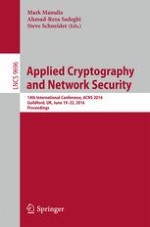2016 | Book
Applied Cryptography and Network Security
14th International Conference, ACNS 2016, Guildford, UK, June 19-22, 2016. Proceedings
Editors: Mark Manulis, Ahmad-Reza Sadeghi, Steve Schneider
Publisher: Springer International Publishing
Book Series : Lecture Notes in Computer Science
